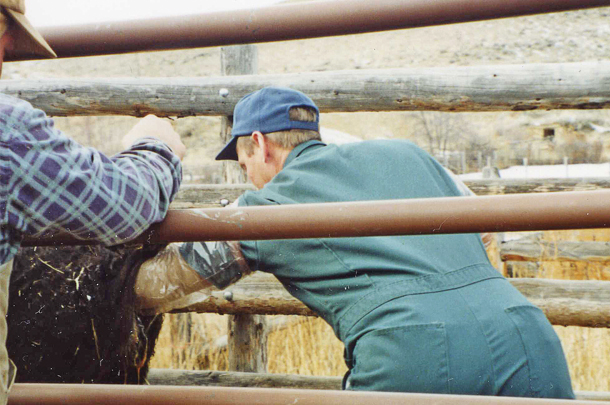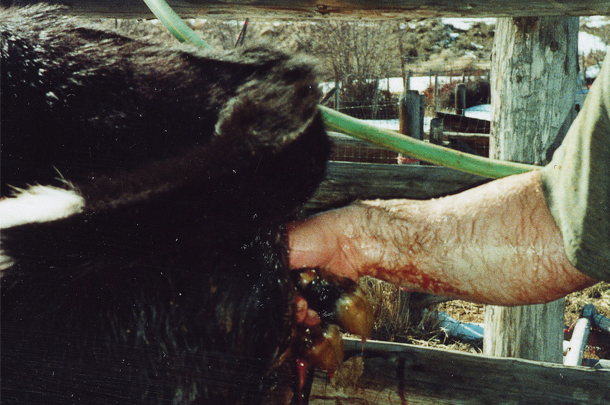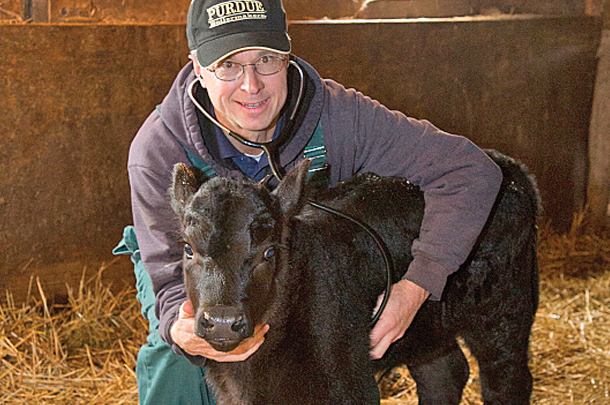The calf entering the birth canal stimulates abdominal straining, and second-stage (active) labor begins to push him out.
Sometimes, however, the calf does not start into the birth canal, and the cow does not begin hard straining. If you don’t intervene, you’ve lost the calf. Knowing when to check a cow is crucial – and you must be watching her to know how long she’s been in early labor.
A serious challenge is the “breech” calf; the only part of his anatomy in the birth canal is his tail. This malpresentation may be difficult to detect, according to Dr. Robert Cope, veterinarian in Salmon, Idaho, since presence of the calf in her pelvis is what stimulates the cow to strain.
“With a breech calf, there is no stimulus for straining. If no water bag is observed, there may be no visible sign that the birth process has begun.”
Cope says that time is the calf’s most deadly enemy in calving difficulty. “As a general rule, assume that a calf has roughly three to four hours of oxygen supply after the cow’s water breaks, since the placenta may begin to detach after that length of time. If no visible progress is made, the cow needs assistance.”
W. Mark Hilton, with beef production medicine at Purdue University, tells producers the rule of thumb he uses is, “Progress every hour. If I don’t see some progress each hour, something is wrong.
In older cows, there is generally a problem, like the head or a leg turned back, the calf backward or breech or some other situation that prevents it from coming into or progressing through the birth canal. In first-calf heifers, lack of progress is usually due to the calf being too big,” says Hilton.
“If you go out at 7 a.m. and she’s off by herself, and by 8 a.m. the water bag is out, and by 9 a.m. feet are sticking out, that’s all progress. If by 10 a.m. there’s no more progress, it’s time to walk her gently into the chute, clean her up, reach in and make sure the head is there,” he says.
“For a mature cow, the number one cause of dystocia is malpresentation. Clients tend to call me quickly on heifers because they think the calf is too big and that they’ll need help from a veterinarian."
"But on cows, they wait, and often wait too long because they think she should be able to calve,” says Hilton. But in waiting too long, the placenta detaches and the calf dies. Then the veterinarian has to deliver a dead calf.
The cow should make progress every hour, just like the heifer. A cow generally progresses faster than a heifer and will often deliver the calf within 15 to 30 minutes from the time the feet appear.
If there are no feet showing, and you suspect she broke her water (or you saw it happen), be suspicious that there’s some kind of holdup. Be aware of when she started labor and keep track of time. If there’s still nothing showing, check her.
The calf may be breech, or the cow might have a torsion of the uterus (creating a twist in the birth canal that prevents the calf from coming through).
In herds where a person is watching cows closely and knows the cows (or has calving records), you can have a history on each cow and know whether she calves fast or slow. If a cow that normally doesn’t spend much time in early labor (or delivers her calf quickly once she starts active labor) is taking longer than usual, don’t wait around; check her.

It helps to know each cow’s individual behavior and history. “I once had a cow that would always separate herself from the herd 24 to 36 hours before she calved, and that was normal for her,” Hilton says. They all have their own patterns.
As Cope says, “The most difficult decision is whether to intervene on a cow who is obviously calving but not in hard labor, making slow or no progress. I feel it is better to assist cows who don’t need help than to neglect a single cow that does. As long as you stay clean and well-lubricated, you are unlikely to cause damage by examining a cow.”
Checking the cow
When you realize the cow needs checked, restrain her and clean her up. “Wash the vulva, use a clean OB sleeve and apply lubrication,” Hilton says. “You have two possible scenarios when you reach into the birth canal. Either you’ll be able to figure out what you are feeling, or you aren’t sure what’s going on – and you’ll call your veterinarian for assistance,” he says.
“If you know what you are feeling, you have two choices. One, you think you can correct the problem and deliver the calf. The other is that you think you need help.
There is no shame in calling for help on the tough ones if it makes a difference in whether you can save a valuable calf. It might be breech (backward, with just the rump trying to come into the birth canal), twins or a uterine torsion. Your veterinarian has seen it all and can assist you. The important thing is to call quickly,” says Hilton.

If the calf is simply too large for easy birth, decide whether you think you can pull it. It’s important to have guidelines, but it can still be a tough call.
“I’ve made mistakes and pulled calves I should have delivered by C-section, and this is hard on the cow and the calf – and sometimes results in a dead calf. You reach in and think that the calf is not that big and start pulling – and get it halfway out and the hips are gigantic and you realize you are in trouble,” he says.
“If the calf’s head is already through the vulva, and its shoulders are starting through the pelvis, we can probably pull it. If I reach in and there’s no space between the calf’s shoulders and the pelvis, I am probably not going to get that calf through. The shoulders are usually slightly smaller than the hips, so if the shoulders can’t make it, you know the hips won’t.
It’s time to stop pulling before we get too far to push the calf back in and do a C-section. If I get the calf halfway out and it’s stuck, I no longer have the option to do a C-section, and there’s no choice but to sacrifice the calf,” he explains.
If a heifer is taking too long and there is nothing showing, check to see if the calf is presented normally. “The head may be turned back,” says Cope. “In an adult cow, head turned back often indicates lack of uterine contraction, but in the heifer, it often indicates lack of sufficient room for the head to fit into the pelvic cavity,” he explains.
If the head is pointed properly, the calf’s nose should be starting through the birth canal, just a little ways behind the feet. But if the cow’s pelvis is halting its forehead, there’s not enough room for it to fit through. Cope’s rule of thumb: “If the cow’s pelvis hits the calf between the eyes, a C-section is needed.”
If you can’t get your fingers over the calf’s forehead – no room between the cow’s pelvis and the calf’s head – push the calf back into the uterus and call your veterinarian. “If it’s borderline, and you’re not sure, call the veterinarian,” says Hilton. ![]()
PHOTO 1: Dr. Susie Lutz dilating a heifer’s vagina before pulling the calf. Photo courtesy of Mark Hilton.
PHOTO 2: Dr. Todd Tibbitts checks a cow to discover malpresentation and fused leg joints on a lupine calf.
PHOTO 3: Prepare to pull a backward calf after checking the cow and discovering its hind feed instead of the front. Photos courtesy of Heather Smith Thomas.
Uterine inertia
Sometimes a cow has poor uterine tone – inability to contract properly and strongly. The calf is not pushed up and into the birth canal on time. As Dr. Robert Cope explains, this is commonly seen in older cows who start labor but no calf appears.

If you examine the cow, the cervix is open; she is in second-stage labor but the calf is still down in the uterus and hasn’t started up over the pelvis yet.
If the calf is in a normal position, it can be easily pulled. But the lack of uterine contractions sometimes result in the calf being malpresented. “With no pressure forcing the calf into its proper position, it may be sitting any way imaginable,” says Cope.
These situations must be discovered soon and the presentation corrected in time to pull the calf while he is still alive.
PHOTO: Mark Hilton. Photo courtesy of Ed Lausch.







